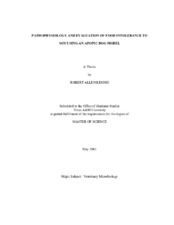| dc.description.abstract | The purpose of the study was to test the hypothesis that dogs sensitized to soy antigen would produce significantly greater amounts of antigen specific IgE antibody compared to a control population before and after challenges with soy, hydrolyzed soy, and non-soy diets. Further, we sought to evaluate important allergenic components of soy using Western blot analysis. Lastly, absorption and mucosal function testing using inert sugars were evaluated for our sensitized and non-sensitized controls.
Eight dogs (6 female, 2 male) were sensitized to whole soy using an established protocol. Seven dogs (3 female, 4 male) roughly age matched were used as controls. The dogs were randomly split into three groups. All dogs were fed an elimination diet of egg and Brewer's rice for six weeks. Samples were collected and each group was fed a diet of soy and rice flour, hydrolyzed soy and rice flour, or corn and rice flour for three weeks. Samples were collected and each group was fed the elimination diet followed by challenge with each of the diets. Serum was collected and stored for allergen specific IgE semi-quantitation and Western blot analysis using whole soy fractionated into globulin and whey components. A solution of monosaccharide and disaccharide sugars was administered in a volume determined by weight. Six hours after administration the dogs were catheterized and the entire urine volume was collected for measurement of sugar recovery by high pressure chromatography, followed by pulsed amphometric detection.
There was a statistically significant difference in serum IgE between sensitized and control dogs after the elimination diet, and also for each of the challenged diets. There were differences detected by Western blot analysis for allergens within the soy globulin and whey fractions for sensitized dogs compared to control dogs. There were no significant differences between sensitized and control dogs for sugar recovery for any of the diets. We conclude that although there were significant differences in measurable IgE between sensitized and control dogs, we were unable to differentiate these groups using gastrointestinal mucosal permeability and function testing. | en |


